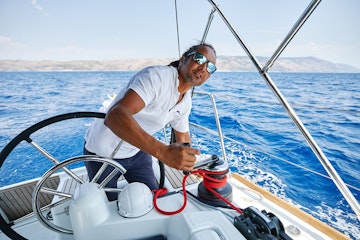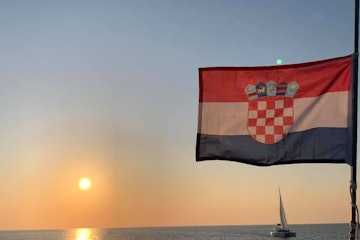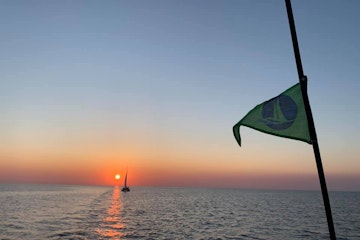Crossing 3 Seas & an Ocean to get our cats’ home

You’d be forgiven for thinking this blog was about a kitten traversing the high seas. Whilst our vessels are loved fiercely as a part of our family, similar to their feline namesake, we are actually talking about the journey our brand new catamarans make on their way to Split, Croatia.
A group of Sail Croatia Skippers have just completed a 5 week journey, taking them from France to Croatia, sailing through the Atlantic Ocean, Bay of Biscay, Gibraltar Strait and Mediterranean, Ioanian and Adriatic Seas on one very important mission; to hand deliver two brand new Lagoon 42 catamarans safely to Croatia.
We check in with Scot Ashby, Lead Skipper onboard one of the Catamarans on this once in a lifetime crossing!

Why are you sailing halfway across Europe in Spring?
We’re sailing Sail Croatia’s newest catamarans home! These vessels are too big to be transported by land, which means the only way to get them back to Croatia is to actually sail them. This gives us the perfect opportunity to test the engines, sails, rigging equipment and onboard navigation systems well ahead of their first Private Yacht Tour or Yacht Charter. Another huge benefit with a crossing of this nature is that it gives Sail Croatia skippers an opportunity to advance their sailing and navigation skills.

What is the total distance covered & how long did it take?
In total we covered over 2,545 nautical miles on this journey across 35 days, sailing through French, Spanish, Portugese, Morrocon, Italian, Albanian, Montenegrin and Croatian waters! The first four days saw us sailing out of France and across to the Bay of Biscay before heading into Vigo, Spain, where we stopped to do a compulsory engine service.
Once we were ready to go again, we sailed south down the coast of Portugal through the strait of Gibraltar and into the City of Gibraltar, where we docked for 5 days whilst sheltering from a weather front. During these five days we were quarantined onboard our catamarans with Covid-19 restrictions. Luckily, one person per vessel was allowed to go to the supermarket to collect fresh provisions, which meant we were luckily able to restock. We used this time to plan wisely and constantly check the situation with the weather. We knew the last leg of our journey would be the most difficult, as we planned to avoid land for 15 days in an attempt to steer clear of a 14 day self-quarantine upon our return to Split.
We managed to navigate the weather and provision successfully so that our plan worked and on the 14th day of our journey, we arrived back into Split safely. After showing Customs officers our GPS tracker and log book to confirm we hadn't been on land for 14 days, we were released from the catamarans we now, well and truly, called home!

Did you stop for supplies, or did you provision for the entire journey?
Normally you would provision enough supplies to last four days, however the instability of Covid-19 meant that we had to prepare for our journey differently. I made the decision to stock up on supplies to cover us for the entire trip, in the event that we were unable to dock for extended periods of time. Of course we were also contending with supermarket supply shortages, so stocking up on provisions was our best option for this journey.

What supplies are required for a crossing of this nature?
We are lucky to be sailing such a spacious vessel for this journey! The Lagoon 42 catamaran has 3 fridges and 2 freezer compartments onboard, as well as multiple storage compartments under the floor, allowing us to store extra supplies and basically live in luxury for the journey!
We provisioned for a 4 week journey just to be safe and filled every hole, compartment and cupboard to the brim! Essentials were the priority; frozen meat, vegetables, pasta, rice, canned food, breakfast cereal, comfort food and of course, a beer or two. When provisioning, it’s important to choose food that can be kept for a few weeks when stored properly and is easy to prepare on the go during potentially challenging sailing conditions.
To additionally prepare, we purchased two 300 litre water storage tanks and fastened one to the centre of the stern and stored one in the saloon. We used this water for drinking, washing ourselves on the deck and brushing our teeth. Fresh water showering doesn’t really exist on long distance journeys like this, so we mostly used buckets of seawater on the stern of the catamaran!
We also had a tank of diesel onboard, totalling 884 litres. This gave us enough fuel to motor the whole way from Gibraltar to Split without stopping in case we needed to.

How does the night watch system work overnight?
The night watch system works from sunset to sunrise, and is divided up evenly between crew members. We had 4 crew members including myself on our boat, so our shifts were 3 hours long, ensuring there was someone on watch from 7pm to 7am daily. From 7am we just begin the rotation again, so one person is on watch while the other 3 crew members are getting some rest.
Weather is the most important part of planning and preparing for your passage. This element needs to be spot on to avoid putting the boat or crew members at risk. During the day we are constantly checking the weather, so if there is an update, we’ll usually have a briefing over dinner on the upcoming weather conditions. If the weather conditions are forecasted to be poor, we will set all sails to suit the weather conditions and ensure the boat is prepared for anything we may encounter. If the predicted weather pattern is too dangerous, we will always plan to head to a sheltered anchor point overnight.
How did you get the opportunity to join the France - Croatia catamaran transfer?
I’ve been working with Sail Croatia for 3 years now; starting as a skipper on the Flotilla. Through training and development, I’ve worked my way through the ranks and am now the Lead Skipper on a flotilla of 6 yachts and catamarans.
I’ve been given the opportunity to learn and improve my sailing skills on this catamaran transfer thanks to the Sail Croatia Skipper Training Program, which will see me continue to develop and move through the program.
Whilst this was an incredible experience, it wasn’t my first Ocean crossing. Previously I’ve also completed a 24 day Atlantic Crossing from the Canary Islands to the Caribbean; a total of 3,464 nautical miles.

What are your top tips for a crossing like this?
As much as it sounds like a sailing holiday with incredible sights, an abundance of dolphins, whales and turtles, it isn’t without its challenges.
To cross these waters with so many fishing vessels, cargo ships and sport vessels, it’s important to be alert and know when and how to react in a dangerous situation if it ever arises. You always hear about floating cargo containers, fishing nets, floating debris, rope and our favourite…. general waste and rubbish floating around, so it’s always important that someone is on watch and keeping us safe.
Managing yourself is also important. Getting yourself into a routine as fast as possible is the key to a successful crossing. Additionally, getting enough sleep and rest, taking care of personal hygiene with the limited amount of water onboard, exercising and not getting sick, all allow you to be fit and healthy to do your part as a crew member.
We were lucky to get good weather which allowed us to get the boats back in one piece. Often the weather can change in an instant and dangerous situations can occur from simple things such as lack of sleep.
There are times when you won’t see land for days, where you’ll have to adjust to a rough sleeping pattern and times when your appetite is completely gone due to exhaustion, but for a certain type of person, the rush and experience of being out in the big blue is unforgettable and something I enjoy so much.
If you’re ever thinking of doing long distance sailing, go for it, but make sure it's right for you!
If you’d like to experience sailing in Croatia, check out the catamarans and yachts available on our Private Yacht Tours and Yacht Charters.

